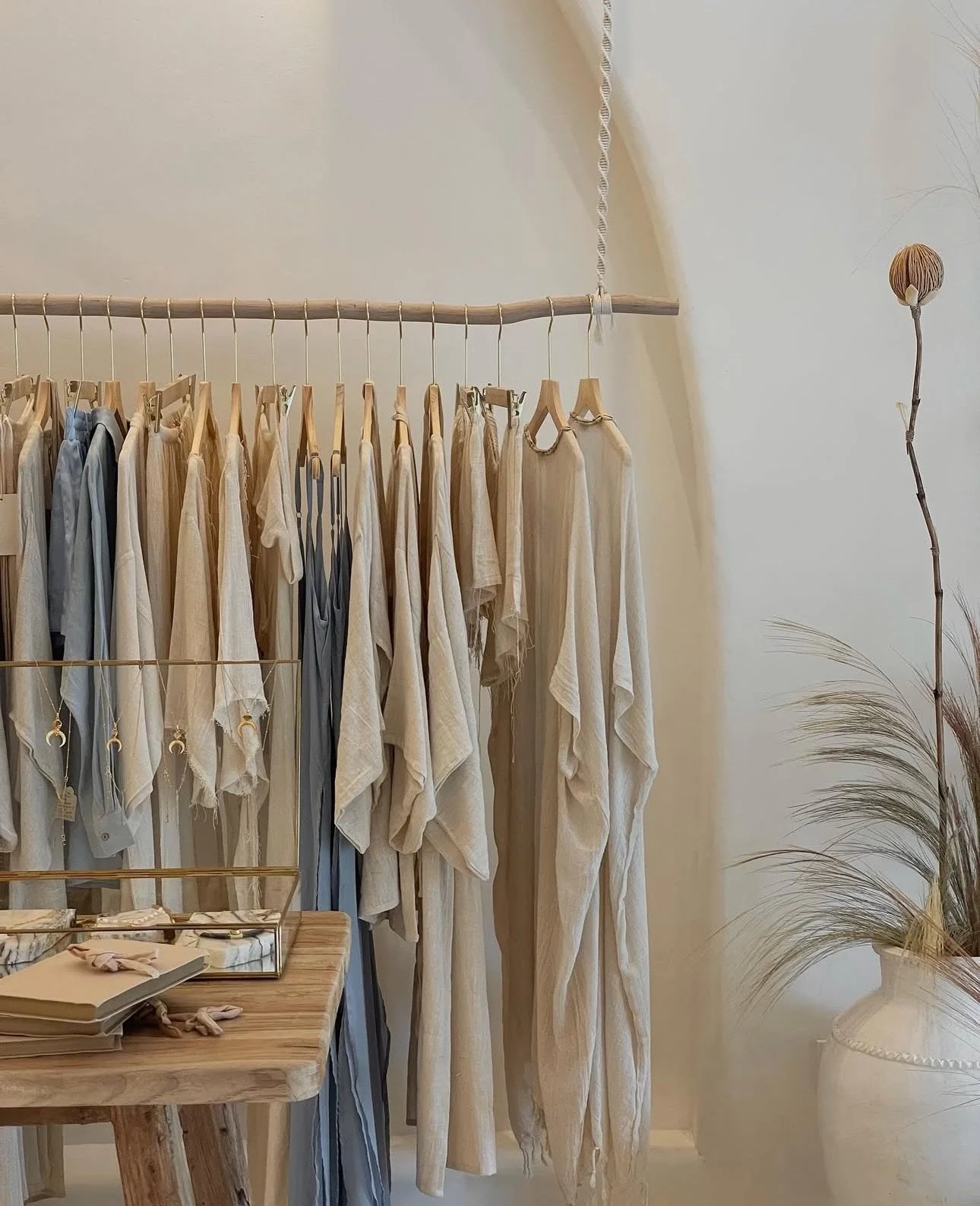
Simple. Still. Meaningful.
The slow living mindset isn’t about moving through life at half-speed—it’s about moving through life on your terms. It’s the quiet decision to tune out the noise and tune in to what truly matters. .
It’s a way of seeing the world that values depth over distraction. It teaches us that time is not something to fill, but something to feel—and that meaning is often found in the space between moments. With slow living, intention leads the way. And in that spaciousness, life doesn’t shrink—it expands.
—
There’s a quiet poetry in the everyday—waiting for anyone willing to pause and truly see it. The way palm tree shadows stretch across a whitewashed wall like soft brushstrokes. The way light dances across the surface of the sea—never the same twice, always moving, always at ease. It’s beauty without effort. Rhythm without rush.
Nothing loud, nothing perfect—just the kind of simplicity that invites touch, presence, and pause. The textures that matter most are the ones time has softened: the worn edge of stone, the faded grain of wood, the linen creased like a smile. Perfectly imperfect pieces that carry their own quiet history—aging the way life does, with a few beautiful wrinkles and stories lived into every surface. These are the moments that make a space feel alive, not styled. Felt, not forced.
STILLNESS. SIMPLICITY. SUBSTANCE.
Slow hosting is the art of creating space—not just to stay, but to feel. It goes beyond aesthetics and amenities to focus on how a place makes someone feel. It’s about presence, care, and heartfelt design. In a fast world, slow hosting whispers: you’re welcome here, just as you are.
__
True luxury isn’t what you give—it’s how deeply they feel at home.
Think of hosting as a gentle art—sharing beauty, purpose, and calm. Our slow hosting guides help you do just that, from soulful styling and guest alignment to meaningful marketing and long-term profit. It’s not about doing more—it’s about doing what matters, beautifully.

Intentional. Present. Unhurried.
Rethinking Tourism, Slowly
It’s not about seeing more—it’s about seeing deeper. Slow travel invites us to trade checklists for connection, speed for stillness, and surface-level snapshots for stories that linger. It’s the art of arriving—not just physically, but emotionally. Of staying long enough to learn the rhythm of a place, to notice the scent of the local bread, or to become a familiar face in the morning café.
It’s not a trend—it’s a transformation. And it’s quietly reshaping what it means to truly travel.
Curious why more travellers are choosing the slow lane? It’s a shift with soul—and it could be the future of hospitality.
The Rise of the Slow Traveller
Forget whirlwind weekends and back-to-back sightseeing—today’s most influential traveller is moving differently. The Slow Traveller is reshaping tourism with a gentler footprint and a deeper presence. They value authenticity over algorithms, choosing soulful homes over sterile hotels, and seasonal dishes over generic dining. Their pace isn’t just personal—it’s powerful. And it’s quietly changing the way destinations, hosts, and travel brands operate.
Want to know what this shift means for you as a host? It’s redefining guest experience, profitability, and purpose in today’s new era of travel.
The Slow Traveller
They don’t rush. They wander. While others race to see the sights, the Slow Traveller is busy feeling them—pausing in the shadow of a crumbling wall, savouring their second coffee at a café where nobody speaks their language, or following the scent of grilled fish down a quiet backstreet. They travel with intention, not itineraries. And when they find a place that feels right, they stay longer. Because for them, it’s not about ticking boxes—it’s about finding belonging.
Curious about what they truly seek in a stay? It’s not what you’d expect—and it could change the way you host forever.
Slow isn’t a trend—it’s a return. A return to the textured, the tasted, the truly felt. In our homes, it shows up as spaces that breathe, where every object has earned its place.
In our wardrobes, it’s clothes that carry stories, not logos—pieces chosen with care, worn with ease, and made to last. At the table, it’s food that’s grown close, cooked slowly, and shared fully. Slow interiors. Slow fashion. Slow food. Three quiet revolutions asking the same thing: What if less rush meant more meaning? What if beauty wasn't in the new, but in the noticed?

Grounded. Textured. Calm.
Rethinking Interiors, Slowly
It’s not about filling a space—it’s about feeling it. Slow interiors invite us to move away from fast makeovers and fleeting trends, and instead choose pieces with presence, materials with memory, and spaces that evolve with us. It’s the art of creating a home that’s not just seen, but felt—a place where light lingers, textures tell stories, and nothing demands attention, yet everything belongs.
This isn’t just design—it’s intention. A quiet celebration of calm, care, and character.
Curious why more homeowners and hosts are embracing slow interiors? It’s a design shift rooted in feeling—and it might just be the future of soulful living.
Style Reimagined
It’s not about owning more—it’s about choosing well. Slow fashion invites us to step off the trend treadmill and into a wardrobe with meaning. One stitched with care, intention, and a story behind every seam. It’s the art of dressing not to impress, but to express—a slower, softer way of showing up in the world, in clothes that feel like home.
This isn’t anti-fashion—it’s mindful fashion. A return to quality, longevity, and quiet confidence.
Curious why more people are rethinking what they wear and why? It’s a shift in values—and it’s shaping the future of style.
A Slower Way to Eat
It’s not about what’s fast—it’s about what’s felt. Slow food invites us to reconnect with the rhythms of nature, the roots of tradition, and the joy of a meal shared, not rushed. It’s the art of cooking with care and eating with presence—of choosing ingredients that are seasonal, local, and full of soul. Meals become more than nourishment; they become memory, ritual, and story.
This isn’t nostalgia—it’s a delicious rebellion against the rush.
Curious why more people are returning to the table with intention? It’s a cultural reset—and it’s redefining the future of how we eat.
Stillness Lives Between the Waves
Slow living is a rhythm, like the waves—steady, unhurried, and full of quiet grace.
It’s the emerald blue of the sea just after sunrise, the way the ripples catch the light and carry time gently forward. It’s the salt in the air, the warmth of sun-soaked stone, the hush between tides. In these moments, life softens. We notice more. We need less. And we begin to remember that stillness isn’t empty—it’s where presence lives, and where the beauty of slow begins.

—
Sand teaches us something about time. It shifts, softly and without rush—shaped not by force, but by rhythm. Each grain a story, worn smooth by the sea, the wind, and the quiet passing of days. You can’t hold onto it tightly—it slips through. But when you slow down, when feel it beneath your feet, between your fingers, and in folds of beach-washed linen, it grounds you. Reminds you to be here. To let go. To surrender to the now. Like slow living itself, sand asks nothing—except that you pause long enough to notice the beauty in the smallest things.
—
The lines on a leaf tell the story of time—quietly, beautifully, without needing to speak. Each vein traces a path, branching and weaving, like moments in a life: connected, curved, sometimes imperfect, always intentional. You can’t rush a leaf into form. It grows slowly, gently, following the rhythms of sun, soil, and season. To pause and trace its lines is to remember that everything is part of something larger. That nothing exists alone. That the passage of time isn’t always linear—it’s layered, living, and full of grace. Just like us.










